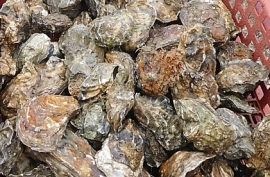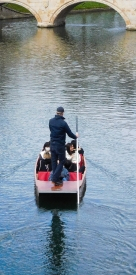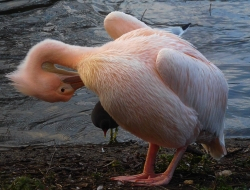Adam Yamey's Blog: YAMEY, page 164
April 21, 2021
After effects
MY FIRST TRIP TO TURKEY was in 1960. I had just finished primary school and was about to start preparatory school (8 to 13 years old) after the summer holidays. That summer we were travelling to Turkey, to Istanbul, where my father was a delegate at a conference. It was deemed necessary to have vaccinations to reduce the risk of contracting typhoid and cholera.

Our family doctor’s surgery in London’s Golders Green was close to my primary school. I had decided to get my ‘jab’ and then to go to school to help organise the annual sports day. When I arrived, I was assigned a task related to the high jump competition. At first, all went well. Then, after a few minutes, I began shivering and felt lousy. I excused myself and made my way home. I spent the rest of the day and the following in bed and the arm in which I was injected felt both painful and heavy. A few weeks later, I was given the second of the combined cholera and typhoid jabs. However, there was little or no after reaction.
Since that jab back in the summer of 1960, I have had numerous, indeed an uncountable number of, vaccinations. Each of these was accompanied by a small amount of discomfort at the site of injection, but no more than that. This was the case until early February 2021.
In February 2021, I was given the first of the two doses of the Oxford Astra-Zeneca vaccine to counter covid19. Within hours of the jab, I began feeling unwell. I did not feel as sick as I did after the first typhoid/cholera jab, but I was not at my best. I did not lose my appetite, nor did I develop an elevated temperature. This feeling of being a little bit ‘below par’ lasted no more than 36 hours. So, it was with some apprehension that I attended the clinic for my second jab in mid-April.
My general medical practitioner, whom I had consulted for another matter, advised me to take two paracetamol tablets (2 x 500mg) just before the jab and another two later in the day. Her advice seems to have been good. Now, nine hours after the jab, I am writing this piece and feeling far better than I did after the first shot of the vaccine. I had been told that just because one has had a reaction after the first injection, it is a matter of pure chance whether one has any reaction after the second. Maybe the paracetamol is working or perhaps I have just been lucky. In any case, I feel happy that I have had the full vaccination as is currently advised.
April 20, 2021
How I avoided an awful fate
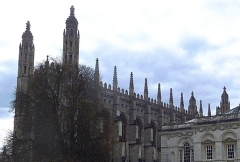 Chapel of Kings College, Cambridge
Chapel of Kings College, CambridgeCAMBRIDGE IS A CITY which I have visited often since I was a child. My first recollection of the place was visiting Gonville and Caius College to meet my father’s long-term collaborator, the Hungarian born economist Peter Bauer (1915-2002). Later, after 1965, during my childhood and adolescence, we used to visit Cambridge to spend time with my father’s friend from his student days in Cape Town (South Africa), the social scientist Cyril Sofer (died 1974) and his wife Elaine. At first, I used to visit them with my family and when I was in my teens, I used to stay with them in their large Victorian house near Selwyn College. It was Elaine, who first introduced me to the joys of the drink known as ‘Bloody Mary’.Further travels to Cambridge followed when a childhood friend of mine attended Clare College to study for his bachelor’s degree. Through him, I met his good friend, now a well-known writer, Matthew Parris.
Many more visits to Cambridge followed my graduation at University College London in 1973. Although I remained in London to study for a higher degree, some of those who had graduated with me moved to Cambridge to pursue further studies. Three out of the nine of us, who graduated in physiology in 1973, embarked on doctoral theses in the city’s university. One of these was Lopa, who is now my wife. While she was at Cambridge, we were still ‘just good friends’, as the saying goes.
On one of my visits to see Lopa, I stayed in a house in Owlstone Road, which is south of the historic centre of Cambridge. A mattress was set up for me in a ground floor room with a street facing window. The room had been recently occupied by a female student, who had moved elsewhere. This sojourn in the city was during the time when the so-called Cambridge Rapist was assaulting young women, always within their homes, at an alarming rate. He carried out his attacks between October 1974 and April the following year.
Apparently, he followed potential victims to their homes and noted down their addresses in a notebook.The rapist carried out his first rape on the 18th of October 1974. Then another on the first of November, and yet again on the 13th of that month (https://en.wikipedia.org/wiki/Peter_Samuel_Cook). The latter was carried out within Homerton College, now a part of Cambridge University. He struck again on the 13th of February 1975, and then, unsuccessfully, on the 5th of May.
I slept soundly at Owlstone Road when I was staying there for a night or two. One morning, I woke up and saw police vehicles out in the road. It was the 8th of December 1974 and the rapist had raped a woman in the house next door to where I was staying, having broken into its ground floor room, which mirrored that in which I was sleeping. What none of us knew until after the perpetrator, Peter Samuel Cook, was eventually caught during his attack on Owlstone Croft’s nurses’ hostel in June 1975, was that the villain had listed the house in which Lopa was living with some other young ladies in his notebook of potential targets. The young lady who had occupied the room where I spent a couple of nights was in the rapist’s list of future victims.
Cook, who had knifed at least one of his victims, was a violent person and might have been awfully annoyed with me had he broken into the room where I was sleeping and found me, a man, instead of one of his intended female targets. Subsequent visits to the wonderful city of Cambridge have not, I am pleased to relate, been so potentially hazardous. Cook was jailed for life and died in Winchester Prison in 2004.
April 19, 2021
A glimpse of Mersea
SOMETIMES SUBMERGED DURING high tide, a causeway connects mainland Essex with the island of Mersea in the Colne and Blackwater estuaries. Markers with measurements are posted along the causeway so that people wishing to cross it when water covers it can tell how deep the water is. Road signs on both sides of the causeway advise drivers to test their brakes, especially if the road to and from the island is wet.
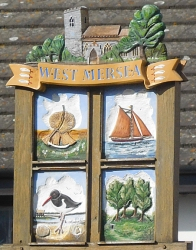
I first heard of Mersea Island in the mid-1970s when a friend of mine, with whom I have lost contact, married someone who farmed sheep on Mersea Island. However, it was only in 2021 that I first set foot on the island. The largest settlement on Mersea is the small town of West Mersea. We visited on the 12th of April, which was the first day (since the latest ‘lockdown began in December last year) that people were allowed to have drinks at pubs and eat meals at restaurants, but only in the open air. Fortunately, the sun was out and the waterfront mostly south facing.
In 895 AD, the island was known as ‘Meresig’; by 995 as ‘Myresig’; and in the Domesday Book as ‘Meresai’. The Old English word ‘mere’ usually refers to a lake (e.g., Windermere) but in the case of Mersea (and Margate) it refers to the sea. Thus, Mersea comes from words meaning ‘the island in the sea’. During the Celtic era (before the Roman conquest), the island was populated mainly with folk who fished and farmed. After the Romans established their capital at nearby Colchester, they built a causeway to Mersea Island and improved an already existing Celtic track (see: “The Shell Book of the Islands of Britain”, by D Booth and D Perrott). The Romans called the island ‘Maris Insula’ and archaeological remains of their presence there have been discovered and are now in Colchester Museum. There is a museum in West Mersea (www.merseamuseum.org.uk/) but this was closed on account of covid19 regulations. It plans to re-open in June.
The Normans also visited the island. The Domesday book recorded that in about 1086 there about 100 persons living on the island along with 300 sheep. The construction of the Church of St Peter and St Paul, which occupies the highest spot in West Mersea, began in 1046. Some of the original structure forms part of the fabric of the present church, which, sadly, was closed when we visited.
West Mersea is a holiday resort. Many fine homes, mostly modern, line the road that runs parallel to the waterfront, but which is separated from it by mudflats and salt marshes. Twenty or so large houseboats are moored at the water’s edge. Each of them has its own, often rickety-looking, boardwalk leading to it from the road. There are several pubs and eateries from which views of the boats moored by the town may be viewed. The town is famous for its oysters. We watched workmen hosing down crates filled with oysters, which look like large knobbly stones. Apparently, the Mersea oysters are highly prized internationally. Interspersed between boatyards for pleasure craft, there are yards where fishing vessels are maintained. At low tide, which is when we visited, the muddy shore is dotted with small boats of all types, some of them gently rotting away.
As it was late afternoon and we had to drive back to London and we had recently been well-fed, we spent no more than an hour in West Mersea. We hope to return when the weather warms up and then we will sample some of the local refreshment outlets. Although Mersea Island is only about 60 miles (and a lot of heavy traffic) from London’s Hyde Park Corner, it feels as if it is much further away: far away from anywhere.
April 18, 2021
A tasty mollusc
April 17, 2021
The river in Cambridge
April 16, 2021
Trouble in the village
TOLLESBURY IS A TINY village on the estuary of the River Blackwater in the English county of Essex, famed for its oysters, nature reserve, and sailing facilities. It is not far from Colchester and the smaller Tiptree famed for its jam manufacture. Tiny though it is, Tollesbury appears in the Domesday Book, with the name ‘Tolesberia’ and in 1218 as ‘Tolesbir’. It is possible that the ‘Toll’ part of the name refers to a person who lived many centuries ago. The Church of St Mary the Virgin that stands at one end of the central village square was built in about 1090, possibly incorporating material from an earlier Saxon Church.
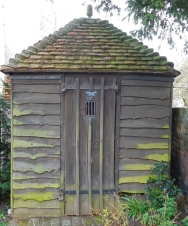
At the southern edge of the square, close to the northern boundary of the churchyard there stands a small wooden hut with a pyramidical tiled roof and one door with a small, barred window. It looks a bit like a garden shed but it was not built for storing tools and so on. For, this was the village lockup or ‘cage’. Built in 1700, it seems in remarkably good condition. The lockup, as its name suggests, was where local miscreants were locked up. It was a tiny prison. The reason that it is in a good state despite its age is that it has:
“…C20 waney weatherboarding, roofed with handmade red clay plain tiles and C20 hip tiles.” (www.prisonhistory.org/lockup/tollesbury-lock-up/)
Essex is home to plenty of village lockups. Apart the lockup from at Tollesbury, you can see village lockups at, for example, Great Bardfield, Thaxted, Canewdon, Great Dunmow, Orsett, Braintree, Roydon, and Steeple Bumpstead (hwww.essex.police.uk/SysSiteAssets/me...).
These miniature jails were:
“… used in the eighteenth and nineteenth centuries to house criminals who were apprehended on suspicion of committing petty crime … Lock-ups were only temporary forms of imprisonment, usually for one or two people, before the local authorities of the day decided how to deal with the offender. Criminals could be released or sent to the closest large town for trial.” (www.essexlive.news/news/essex-news/historic-jails-essex-you-can-3227277)
Our friend, who lives in Tollesbury, suggested that probably the lockup was often used to house people who had drunk too much and needed to sober up. This not an unreasonable idea considering that at one time the village had six pubs.
Although there is much more that could be written about Tollesbury, I hope to do this after a future visit to this charming little place.
April 15, 2021
An avian question
April 14, 2021
Some illustrious corpses
THE ARTIST CONSTABLE is one of the best-known people to have been interred in the cemetery of St John’s, the parish church of Hampstead. His grave is in the older part of the cemetery which surrounds the church. Across the road from the church and running along the east side of Holly Walk, there is an extension of the cemetery, the Additional Burial Ground, almost completely filled with the graves of people, who died in the 19th century and later. Apart from the graves covering the gently sloping cemetery, there is a pleasant, peaceful sitting area in its south eastern corner and an attractive columbarium (containing wall-mounted memorial plaques) in its north eastern corner. For several centuries, Hampstead has attracted residents from a wide variety of walks of life, and this is can be seen by wandering around the cemetery. Several of the many gravestones attracted my interest and aroused my curiosity about the lives of the people buried beneath or beside them. I have chosen a few to write about because they were clearly notable people, but individuals about whom I knew nothing.
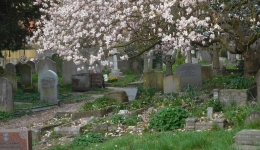
Thomas Frederick Tout (1853-1929) lies buried close to the Labour politician Hugh Gaitskell (1906-1963) and the Austrian born actor Anton Walbrook (1896-1967), both of whom are better remembered than Tout, who is described as “historian” on his gravestone. Born in London, Tout specialised in the history of the mediaeval era. At first, after graduating at Oxford, he taught at the University of Lampeter in Wales, then later at what was to become the University of Manchester, where he introduced the idea, an innovation, of making final year history undergraduates produce a final year thesis based on study of original sources. Just before Tout retired in 1925, he moved to Hampstead where he and his wife lived at 3 Oakhill Park until his death.
Tout lies at the bottom end of the sloping cemetery, while another academic, Randolph Schwabe (1883-1948) is interred at the top end. Schwabe was born in Eccles near Manchester. His paternal grandfather was born in Germany and migrated to England. At the age of 14, Randolph enrolled at the Slade School of Fine Art (University College London) and showed great skill in drawing, painting, and etching. During WW1, he was an official war artist. Following the end of the war, he taught fine art at both the Camberwell and Westminster schools of art. In 1930, he became the prestigious Slade Professor of Fine Art at University College and then Principal of the Slade School of Fine Art. When war broke out again in 1939, he became involved in official recording of the war, receiving a special commission to document the bomb damage to Coventry Cathedral. In addition to teaching, Schwabe was a prolific book illustrator. For health reasons, he moved to Helensburgh in Dunbartonshire, where he died whilst still Principal of the Slade. He was cremated and his ashes were scattered in the cemetery in Hampstead where a beautiful stone sculpture of a woman with bowed head, created by Alan Durst (1883-1970) commemorates him. Schwabe lived close to the cemetery in Church Row (no. 20).
Not far from Schwabe’s monument, there is an ensemble of gravestones remembering the lives of the Matthews family. Bert Matthews (1884-1974), a local rat catcher, was Hampstead’s Pearly King for 40 years (www.museumoflondon.org.uk/discover/six-things-you-never-knew-about-pearly-kings-queens). In 1905, Bert married Becky in Hampstead Parish Church (https://tombwithaview.org.uk/abg-people/bert-matthews/). They lived in Perrins court. Three years before his marriage, Bert became involved in charity work. Bert and his wife became Pearly King and Queen of Hampstead. The ‘Pearlies’ dress up occasionally in clothes that have been covered with mother-of-pearl buttons and so attired, they collect money for charity. Like royalty, the Pearly Kings and Queens hand on their titles to their offspring. Although dressing up in the pearly button covered costumes is part of the fun, the Pearlies are dedicated to raising money for good charitable causes. Three generations of the Matthews family are buried near to the Holly Walk edge of the cemetery, the bodies of three generations of Hampstead’s Pearly Kings and Queens lie together. To see the Pearlies of Hampstead, watch the video on www.britishpathe.com/video/pearly-kings.
Buried close to the working-class Pearly aristocrats, we find an ostentatious monument commemorating some other aristocrats, who would not have considered themselves working-class. It is in memory of three female members of the family of Frederick Ramon de Bertodano y Wilson, 8th Marquis de Moral (1871–1955). Born in Australia, Frederick went to England in 1895, where he trained as a lawyer. He served as an officer in the British Army in southern Africa during both the Matabele War (1896-1897) and the 2nd Anglo-Boer War (1899-1902). Then, he returned to England in 1905 (https://campbell.ukzn.ac.za/?q=node/47011). In 1907, he married Lady Ida Elizabeth Dalzell (1876-1924), who is buried in the cemetery along with their daughter Marie Stephanie Stewart (1911-2009), née de Bertodano. Frederick Ramon is not buried in Hampstead but in Harare, Zimbabwe (www.geni.com/people/Fr%C3%A9d%C3%A9rik-Ramon-de-Bertodano-8th-Marquis-de-Moral/6000000012386542530). He retired to what was then Southern Rhodesia in 1947. I am not certain why this monument is in Hampstead. The only clue I have found is that Frederic was listed in 1906 as being a Fellow of The Royal Geographic Society living at 43 Belsize Square. However, this was before he married. Marie Stephanie’s brother Andrew was born in Hertfordshire in 1912. I would like to know more about this family’s connection to Hampstead.
The last of the graves of the many fascinating people, whose remains rest in the newer part of the cemetery of The Parish Church, records the deaths of the Llewellyn-Davies family. The barrister Arthur Llewellyn-Davies (1863-1907) married Sylvia Jocelyn Du Maurier (1866-1910), daughter of the cartoonist George Du Maurier, who is buried in the cemetery. They had five sons. After Arthur died, the family’s friend, the author JM Barrie (1860-1937) supported Sylvia and her boys financially. When she died, Barrie became one of the boys’ guardians (https://androom.home.xs4all.nl/biography/p008514.htm). Most readers will know that Barrie is famous for his book “Peter Pan” (first published 1911). Barrie’s inspiration for Peter Pan was Arthur and Sylvia’s son Peter (1897-1960), who is remembered along with his parents at the family grave in Hampstead. Michael Darling, another character in “Peter Pan” was based on Michael Llewellyn-Davies (1900-1921), who drowned when bathing at Oxford while he was an undergraduate student. You might be wondering about Peter Pan’s companion Wendy. It so happens that I have seen her grave, that of Margaret Henley (1888-1894), who is buried at Cockayne Hatley in Bedfordshire. Her father was a friend of JM Barrie, whom the small child Margaret referred as her “fwendy-wendy”. This caused Barrie to name his heroine Wendy. The Du Maurier family is intimately associated with Hampstead. So, it is unsurprising to find the Llewellyn-Davies family memorial where it is.
Enough of this morbid subject. Now, you need to visit this fascinating cemetery in Hampstead to discover more for yourself. And when you have had enough of looking at the resting places of illustrious corpses or their ashes, it is but a short walk along the attractive Church Row to reach the heart of Hampstead with its numerous cafés, where you can enjoy a life-restoring beverage.
April 13, 2021
A collector, a composer, and police constables
LIKE ROME, HAMPSTEAD in north London perches on several hills. A short street, Holly Walk, leads uphill from Hampstead Parish Church towards the summit of Mount Vernon, one of Hampstead’s ‘peaks’. On the southern corner of Holly Walk and the short cul-de-sac Holly Berry Lane, there stands a house, number 9 Holly Walk, that bears the name ‘The Watch House’. It was from this building, constructed in the early 19th century (c1830), that during the 1830s (1830-1834), members of Hampstead’s newly established Police Force set out on patrol and night watch. The Regency era Windsor lantern attached to the Holly Berry Lane façade is of antiquarian interest (https://historicengland.org.uk/images-books/photos/item/IOE01/15703/07). The main entrance to the building was the doorway in Holly Berry Lane; it is surmounted by a bas-relief of a lion’s head. By 1834, the police had moved to the bottom of Holly Hill opposite where the Underground Station stands now.
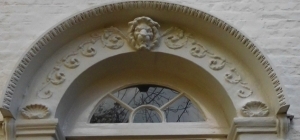
Next
door to the former police house with its entrance on Holly Berry Lane is a
house in which the composer Sir William Walton (1902-1983) lived in about 1939,
although I am not sure exactly when. Walton used to visit Hampstead in the 1920s
while he was composing Façade (first performed 1923), a musical setting of
poetry by Edith Sitwell (1887-1964), who was living at Greenhill, a block of
flats on Hampstead High Street. Later in life, she lived in Keats Grove.
Directly
across Holly Walk opposite the former police station, there is a large,
detached building called Moreton House. This was built in 1894-1896 in what the
architectural historian Nikolaus Pevsner describes as “… the style of a
Jacobean manor house.” The house originally had extensive terraced gardens, but
these are now covered with late 20th century houses. It was designed by Thomas Garner (1839-1906). Its
first owner was the art historian and collector Frederick E Sidney, about whom
I have discovered only a little. His
motto, which can be found in various places in Moreton House was “God is in Al
and in Al thinges”. A Fellow of the Society of Antiquaries, he was born before 1855
and died in 1932. In 1903, he published a travel book called “Anglican
innocents in Spain”. In 1937, after his death, Christies auctioned his
collection of ancient and modern pictures and drawings. The proceeds of this
sale were given to the beneficiaries of his will. Apart from the information
that he had a Torpedo model Rolls Royce Silver Ghost made for him in 1914, I
can discover little more about Mr Sidney. It seems that currently Moreton House
is divided into luxury flats.
The
three buildings I have described are within a few feet of each other. They are
close to the Catholic church on Holly Walk and the cemetery next to it. There
is so much history in such a small area, as is the case for the rest of
Hampstead. This is one of many things that endears me to the small hill town
that has been absorbed into the metropolis of London without losing too much of
its unique character.
April 12, 2021
A tavern on the Thames
THE BATTLE OF TRAFALGAR, fought in 1805 in the waters off Cape Trafalgar on the Atlantic coast of Spain, was a major victory for British naval forces under the leadership of Horatio Nelson (1758-1805). Sadly, it was after that battle that Nelson died, having been hit by a bullet fired from the French vessel “Redoubtable”. Most people are familiar with Trafalgar Square in central London, which commemorates the great victory. Fewer people might be familiar with a riverside hostelry in Greenwich, which also celebrates the battle.
The majority of visitors to Greenwich concentrate mainly on the Cutty Sark, the Royal Naval College, the Greenwich Meridian, the Naval Museum, and Greenwich Market. The Trafalgar Tavern is, I suspect, not on everyone’s list of things that must be seen on a visit to Greenwich. It is located on the riverbank immediately east (downstream) of the former Royal Naval College (now partly occupied by the University of Greenwich).
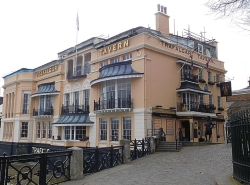
Before dealing with the tavern, let me digress a little about the origin of the name Greenwich. In the Anglo-Saxon Chronicle, first written in the 9th century, the place was called ‘Grénawic’ or ‘Gronewic’, meaning ‘the green village’. The Scandinavian invaders of Britain might have given it a name meaning ‘the green reach’. The Domesday Book of 1086 lists it as ‘Grenviz’. In 1291, a document called it ‘Grenewych’, which is close to its current name. During the 18th century the hitherto principally naval town also became a popular resort.
The Trafalgar Tavern was built in 1837 to the designs of the architect Joseph Kay (1775-1847), who helped to design the centre of Greenwich, on the site of an older inn, The Old George Tavern. In 1830, the owner of the Old George had wanted to enlarge his premises, but his ideas were sabotaged by the architect he had employed, who could see great potential for the inn and then decided to acquire the pub for himself (www.trafalgartavern.co.uk/history). The new owners of the pub submitted numerous plans for enlarging it until at last in 1837, they got the go ahead to proceed. The elegant building, with bow windows covered with canopies, looking out over the river, that exists today is what they built and re-named The Trafalgar Tavern in 1837.
The tavern’s name was well-chosen. After Nelson was shot, his body was returned to England, where it landed at Spithead. Eventually, Nelson’s embalmed corpse was transferred to Greenwich Hospital, where it was examined (https://www.navyhistory.org.au/the-preservation-of-horatio-lord-nelsons-body/). On the 5th of January 1806, the body lay in state in the magnificent Painted Hall of the hospital. The pub’s name was chosen, according to the Trafalgar’s website, because of its proximity to this place, which is about 200 yards away. In accordance with his wishes, Nelson was buried at St Pauls Cathedral.
Writing in 1876, James Thorne noted that the Trafalgar and other riverside inns in Greenwich were “… all celebrated for their whitebait dinners…” The Tavern’s history website explains that the whitebait were cooked after being caught fresh from the Thames. From the late 18th century onwards it became the fashion for parliamentarians to travel by boat from Westminster to Greenwich to discuss politics discreetly over a dinner of whitebait at one of the riverside hostelries, including the Trafalgar, which was favoured by the Liberals and The Ship that was favoured by the Tories (www.foodsofengland.co.uk/whitebait.htm). The writer Charles Dickens visited the Trafalgar frequently. It is said that he based the wedding dinner scene in “Our Mutual Friend” in the inn. I did a word search of an online edition of the novel and failed to find the name ‘Trafalgar’. However, it has been noted that the dinner took place in “…a dinner at a hotel in Greenwich overlooking the Thames…” (https://victorianweb.org/art/illustration/mstone/44.html). Some of the other notable visitors to the Trafalgar include William Makepeace Thackeray, JMW Turner, William Gladstone, and Benjamin Disraeli.
After WW1, the Trafalgar became used as a home for retired sailors. Later, it was used as accommodation for serving naval officers. In 1968, the place was restored to its original Victorian glory and it became a pub once again. Since then, well at least until the covid19 pandemic, the place has been serving drinks and food including whitebait, although the source of this ingredient is unlikely to be the water flowing past the Tavern.

